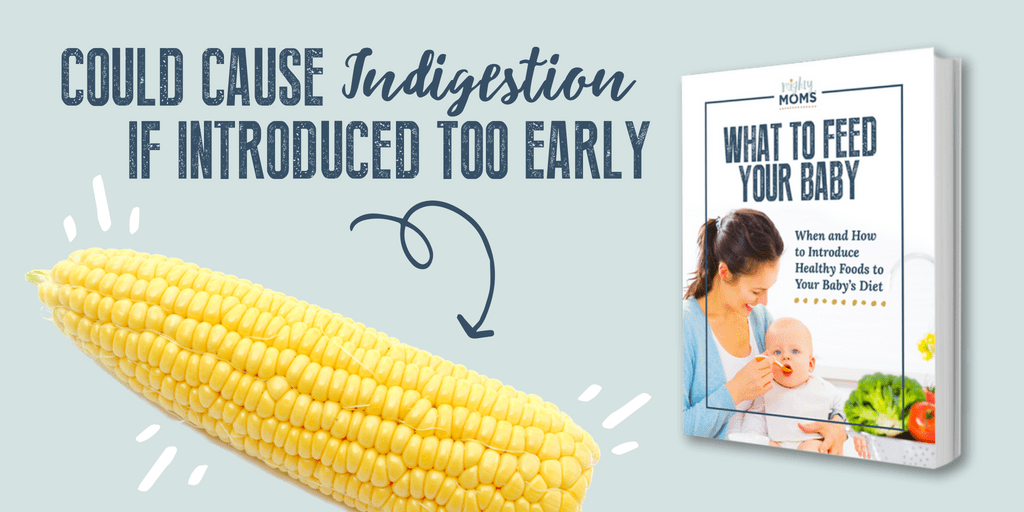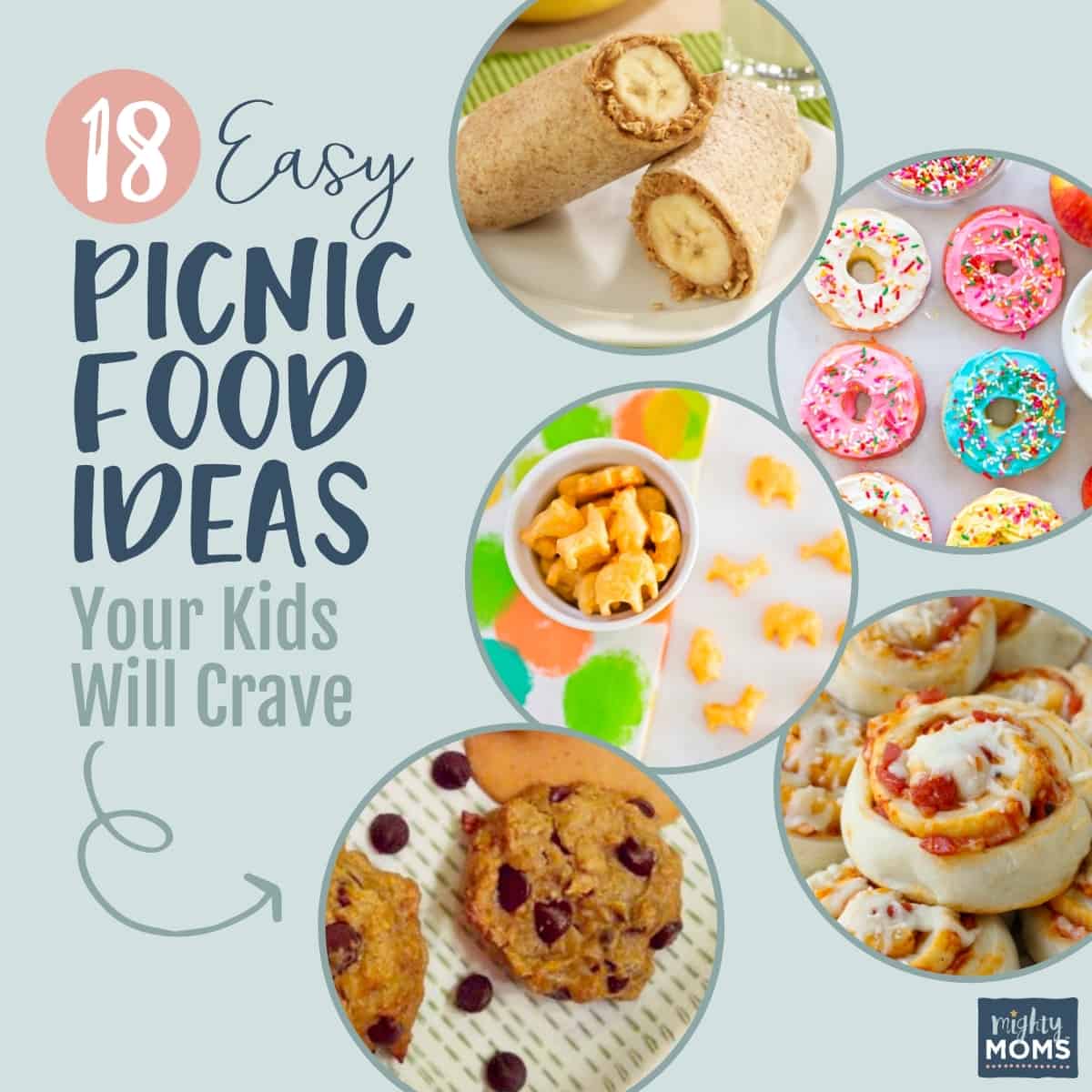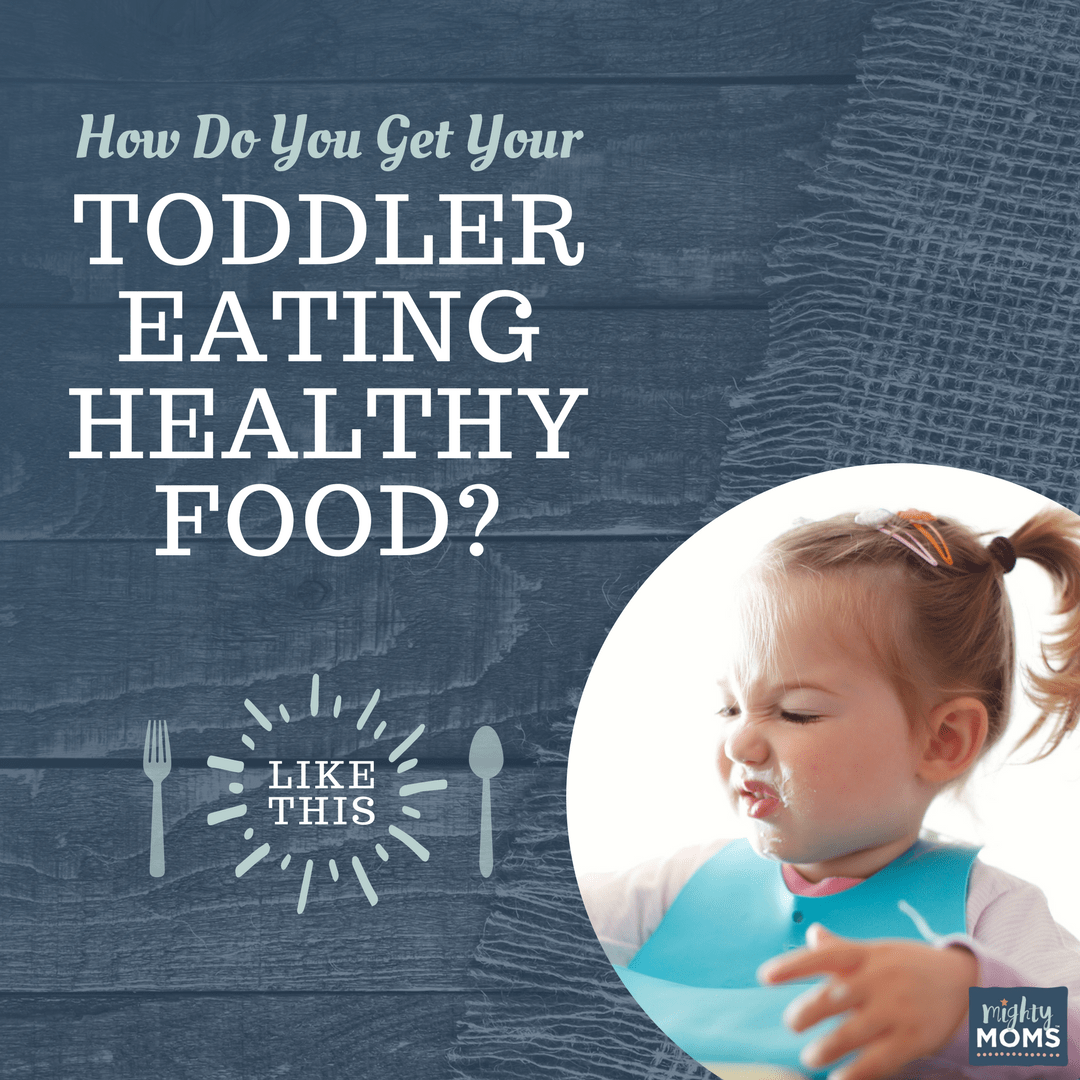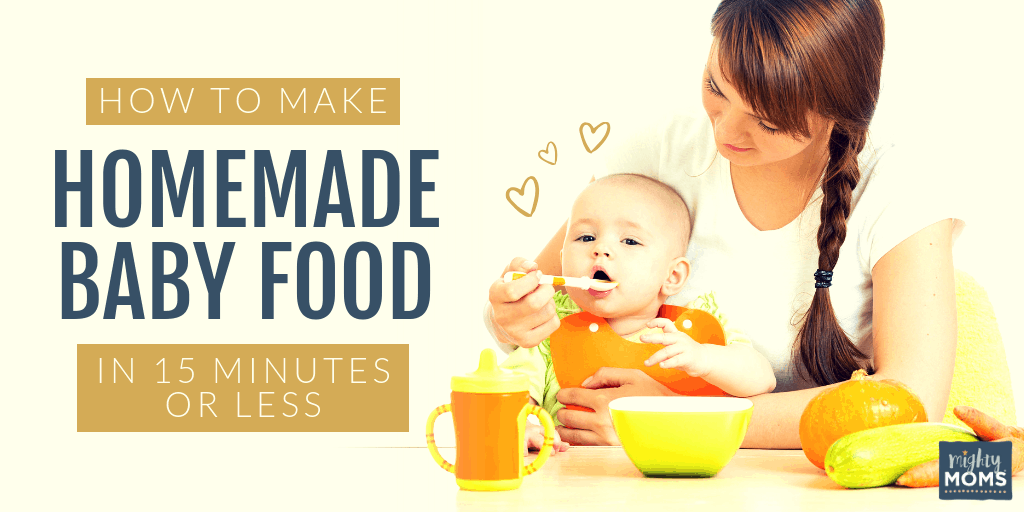
There’s a big fat LIE circulating around when it comes to homemade baby food. Here it is: Making homemade baby food is time-consuming and hard.
WRONG. Making homemade baby food is actually easy. And I don’t mean Martha Stewart “easy” either. (…and with these 7 simple steps and 4 made-from-scratch items you prepared yesterday, you TOO can prepare “Mediterranean Chicken and Orzo Salad with Hand-Roasted Peppers and Homemade Sun-Dried Tomatoes for your baby!”)
Nope. I mean EZ. (Which is the easier way of saying easy, btw.)
Homemade Baby Food in Four Steps
Yes, I said FOUR STEPS and, really, the first one doesn’t even count.
- Take out the food—30 seconds
- Overcook the food—9 minutes
- Puree into slurpee-consistency—3 minutes
- Feed or freeze—2 minutes
What is your total time commitment? 14 minutes, 30 seconds. BOOM, baby!
So will this conclude my article?
Pshhh—I’m way too long-winded to stop here! Let’s unpack those steps, shall we?
Homemade Baby Food Step #1
Take Out Food
Obviously, this begs the question: What food do you take out?
Leftover Famous Dave’s? A bag of Cheetos? Cold Pizza?
Righhhhht. No.
Starting at around 6 months, you’ll want your baby to eat only fruits, veggies, grains, beans, and WELL-pureed meats until she’s closer to her first birthday.
Can I start at 4 months? The American Association of Pediatricians (and my humble self) recommend waiting until baby is closer to 6 months. The tongue movements to eat are much different than those to drink from a bottle or breast. Also, it’s a myth that solids at night will help your baby sleep better at night. It won’t work, friend. Let a professional show you methods that will.
A baby who’s trained to think sweet = carrots and not sweet = cookies, will be much easier to feed in the pickier toddler years.
Feed Your Baby with Confidence
The foods you take out of the fridge for “baby food” will depend largely on your baby’s age. There are certain foods you don’t want to introduce to your baby too early. My little booklet What to Feed Your Baby provides a wealth of information on when and how to introduce the healthy fruits and veggies you want your child to fall in love with.
- Every fruit and vegetable is alphabetically organize for quick at-the-table reference.
- It lets you know when it’s safe to introduce each food, and what side effects you may see pop up as a result.
- There’s a ripeness chart so you can shop in-season and save.
- Speaking of saving, I’ll also point out the fruits and vegetables that you should seriously consider purchasing organic, and when it’s not worth the extra cost.
Homemade Baby Food Step #2
Prepare the Food
Naturally, how your prepare your homemade baby food will have a lot to do with the foods you’re pulling out of the fridge to prepare.
That said, there’s one principle in making homemade baby food that will make all you Nervous Nellies in the kitchen happy: overcook everything.
Here are a few homemade baby food cooking tips:
- Preparing grains? Use a coffee grinder to break down the brown rice (or other grain) into dust before cooking.
- Use a steamer basket or microwave steamer bag to cook your vegetables and fruits until mushy.
- Prepare your baby’s food while you’re cooking for the rest of the family. Just leave your baby’s food in there a little longer (after checking your quick food reference guide first, just to make sure it’s safe!)
- If cleaning the kitchen isn’t on your “fun times” list, this baby food maker does all these steps on their own. Dump in, pour out, and freeze. Done!
What About Allergies?
Lots of things have changed when it comes to babies and allergies since my kids were little. Doctors are actually encouraging parents to introduce allergens earlier than before. This article gets into the details—a good thing to read through!
If your baby is starting a new food, I would recommend presenting it exclusively for breakfast and lunch for three days straight. This way if he has eczema or hives, you’ll know the culprit. (Don’t offer it at dinner, because you don’t want symptoms showing up overnight and ruining everyone’s sleep!)
Homemade Baby Food Step #3
Puree into Paste
You’ve peeled your bananas, de-pitted your avocado, and sliced your mango without losing any fingers. *highfive*
Finally! Your Overcooking Super Powers have come in handy! The food is a glorified mush in the pot. Time to use a blender and some breastmilk or formula, and transform that food into a slippery paste (for beginners) or wet mush (for advanced eaters).
Texture is an important concept in cooking, yes, but not when your client is 6 months old.
Your “preparation goal” should be to make the food as soft as possible. You want it slipping off the spoon and sliding down his throat.
When it comes to learning how to eat solid foods, your baby’s first instinct is going to be to approach it like a bottle: suck the food. It will take him a while to learn that the tongue actually needs to go in the opposite direction when eating solid foods.
Make this learning process easier by giving him solid foods that are just a little thicker than the breastmilk or formula he’s been used to slurping.
As he starts to get the chewing and swallowing rhythm down, you’ll be able to introduce more and more chunky finger foods, but when you’re just starting off, I recommend making it slurp-happy.
What About Baby Led Weaning?
There’s an alternative method out there when it comes to homemade baby food called Baby Led Weaning. Basically, instead of messing around with purees and blending foods, you just sit him at the table with the rest of the family and give him finger foods to experiment with. If this fits your parenting style, go for it. (This book can help.)
Personally, though, I have a phobia about choking, so that method always made me nervous because it admits there’s going to be gagging as your baby learns how to eat.
That’s me, though.
If you want to give it a try, here’s the book that started it. I would, however, stick with this schedule of foods. No matter how you prepare it, some foods are going to give your baby’s digestive system a hard time if introduced too early.
Homemade Baby Food Step #4
Feed or Freeze?
At this point, you’ll have two options to choose from the homemade baby food you just prepared:
- Do I feed this to him today?
- Or freeze it for later?
Option A: Feed Him Today
Simple, put a few tablespoons (enough for a serving) into covered containers and store in the fridge for the next 48 hours.
Why bother with the individual bowls? Dipping the spoon into the food with saliva on it will cause the food to immediately begin to break down. Pre-dividing the portions will prevent you from ruining the whole batch in the first feeding.
Once you’ve done the 3-Day Allergy Test (see above) you can start mixing foods. When my Lauren was 9 months old, her favorite food was plain yogurt, pureed avocado, and crumbled cooked egg yolks.
Yes.
That’s gross.
When I offered avocado alone, she would spit it out, defiantly. When I was a Sneaky Ninja Mom, though, and slid avocado into this ba-nasty yogurt concoction, she gobbled it up. So before you give up on a food, try mixing it with a few other favorites you know she likes and see what happens!
Option B: Freeze for Later
If you’re making a lot of homemade baby food, you’ll definitely want to freeze it in portions for later use. I really like these Wee Sprout silicone molds.
- Load up this container with homemade baby food.
- Pop them in the freezer overnight.
- The homemade baby food slides out easily in the morning, where you can put them inside marked Ziploc bags, or these reusable pouches for on-the-go feedings.
Then, every evening look in the freezer and pull out the homemade baby food you want to feed use the next day, letting them thaw in the fridge overnight. When you’re ready to serve, just mix in some warmed formula or breastmilk until you get the consistency you’re looking for.
Yes, you can warm homemade baby food up in the microwave, but be sure to cook it on LOW and go in 10-second increments, stirring each time to make sure it doesn’t get too hot. (Test with your finger.) The food needs to be lukewarm. Babies have very sensitive mouths!
Making Homemade Baby Food
Smart Tools for the Trade
Ready to give this simple process a try in your own home kitchen? Here are the homemade baby food tools I would suggest you start with, along with some of my favorite bibs and most innovative utensils!
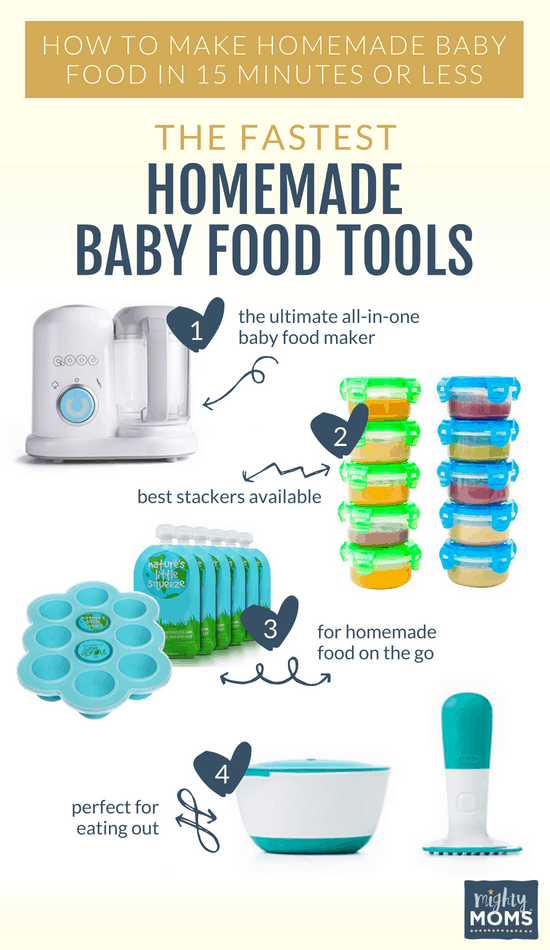
Homemade Baby Food Tools
1. 4-in-1 Baby Food Maker | 2. Baby Food Storage
3. Freezer Tray & Pouches | 4. Food Masher
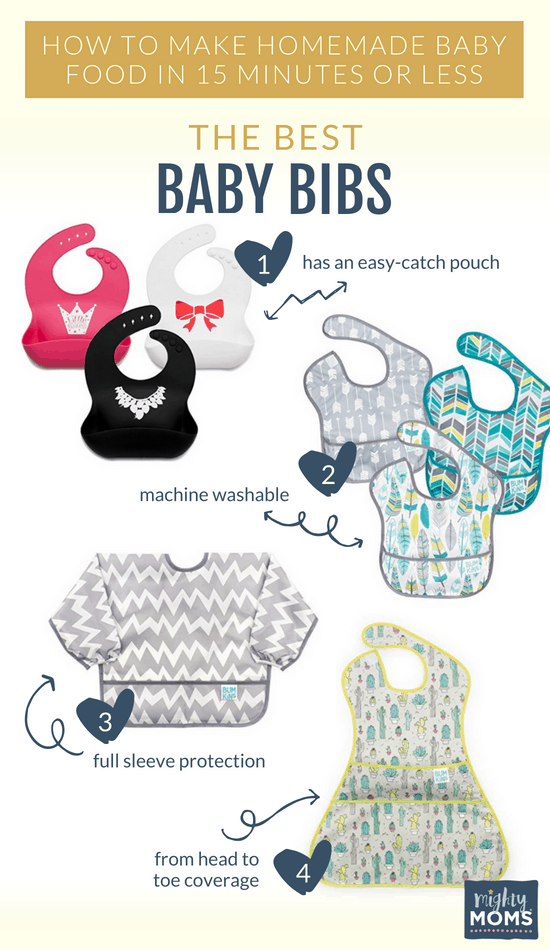
The Best Baby Bibs
1. Food Catchers for Girls and Boys | 2. Bumkins
3. Sleeved Bib | 4. Full Body Bib
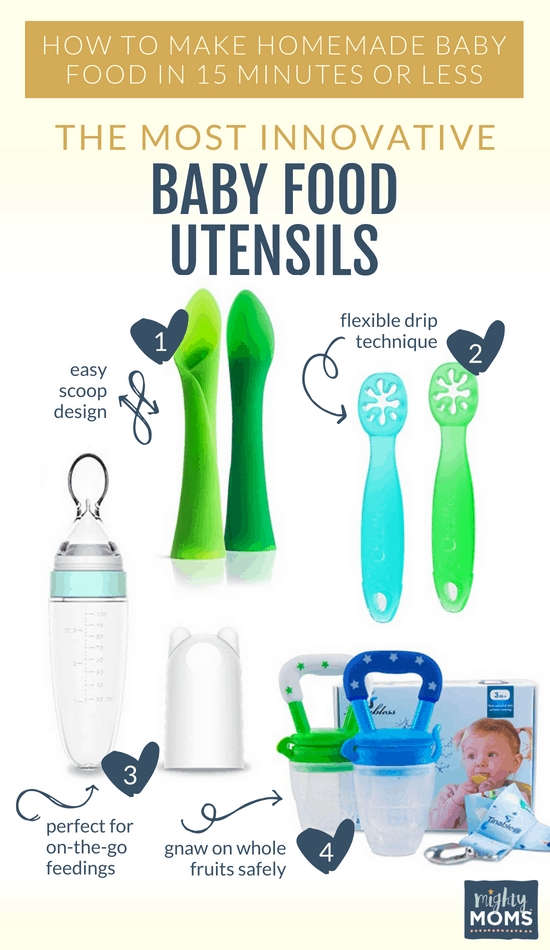
The Most Innovative Baby Food Utensils
1. Olababy Spoon | 2. ChooMee Flexidip Spoon
3. Burabi Feeding Spoon | 4. Teething Feeder
Time for a Homemade Baby Food Quiz!
Repeat after me:
Making homemade baby food is easy.
Again.
Making homemade baby food is easy.
Okay, I think you might be ready for the hardest test you’ll take today. Ready? DEEP BREATH. Here we go: Is making homemade baby food hard?
No. Making homemade baby food is easy.
Hooray!! You passed!
See how simple this process is? Sure, it may not be as easy as popping off a jar lid, but with baby food running $3-4 a jar…that’s a lot of extra Benjamins at the end of the year.
So, sitting on the scale, we’ve got 14 minutes and 30 seconds of homemade baby food effort of this side…and a pile of Benjies on the other. Which way is your scale tipping?
Why not set aside 15 minutes on Saturday and give it a try? You’ll feel like a rock star mom, and your little one can figure out that he really (really) loves mango and avocado smoothies!
We ♥ honesty! This post contains affiliate links that provide extra money for our mutual coffee habits addictions. Click here to learn more. As an Amazon Associate I earn from qualifying purchases.
